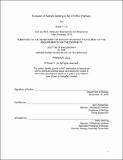| dc.contributor.advisor | Cheeseman, Iain | |
| dc.contributor.author | Liu, Grace Y. | |
| dc.date.accessioned | 2023-03-31T14:34:12Z | |
| dc.date.available | 2023-03-31T14:34:12Z | |
| dc.date.issued | 2023-02 | |
| dc.date.submitted | 2023-03-03T06:01:39.651Z | |
| dc.identifier.uri | https://hdl.handle.net/1721.1/150126 | |
| dc.description.abstract | The mTORC1 pathway regulates growth and metabolism in response to nutrient availability. In mammals, the mTORC1 pathway monitors the concentration of certain amino acids using dedicated nutrient sensors, which bind directly to their cognate metabolites. Unlike other components of the mTORC1 pathway, which are present from yeast to human, the known nutrient sensors are poorly conserved in lower eukaryotes and may have emerged as specialized innovations. A goal of mTORC1 biology is to understand the evolutionary mechanisms that allow a highly conserved core pathway to adapt to the diverse nutritional niches that animals occupy. How does the mTORC1 pathway add new layers of regulatory sophistication to accommodate animals with divergent diets and lifestyles? Do organisms acquire novel nutrient sensors under environmental pressure? If so, where do those sensors come from?
In this thesis, we discover a new species-specific S-adenosylmethionione (SAM) sensor and use its evolutionary history to pry open the structural logic of the mTORC1 pathway. We show that the sensor, the Drosophila melanogaster protein Unmet expectations (Unmet, formerly CG11596), is an “evolutionary intermediate,” caught between its ancestral enzymatic function and a recently acquired role in the mTORC1 pathway. Unmet interacts with the fly GATOR2 (dGATOR2) complex, a core component of the pathway, to inhibit dTORC1 during methionine starvation. This inhibition is directly relieved by SAM, a proxy for methionine availability. Unmet expression is elevated in the ovary, a methionine-sensitive niche, and flies lacking Unmet fail to maintain the integrity of the female germline under methionine restriction. By tracing Unmet’s incorporation into the mTORC1 pathway, we show that Unmet was an independent methyltransferase before it was captured by flexible loops on the GATOR2 complex. These data suggest a general mechanism in which the mTORC1 pathway assimilates new sensors by using evolvable modules on core complexes to co-opt proteins with ligand-binding capabilities. We discuss how similar principles can be used to build artificial sensors for the mTORC1 pathway and explore how repurposing ancient enzymes enables the mTORC1 pathway to rapidly adapt to metabolic niches across evolution. | |
| dc.publisher | Massachusetts Institute of Technology | |
| dc.rights | In Copyright - Educational Use Permitted | |
| dc.rights | Copyright retained by author(s) | |
| dc.rights.uri | https://rightsstatements.org/page/InC-EDU/1.0/ | |
| dc.title | Evolution of nutrient sensing in the mTORC1 pathway | |
| dc.type | Thesis | |
| dc.description.degree | Ph.D. | |
| dc.contributor.department | Massachusetts Institute of Technology. Department of Biology | |
| dc.identifier.orcid | https://orcid.org/0000-0001-5463-3055 | |
| mit.thesis.degree | Doctoral | |
| thesis.degree.name | Doctor of Philosophy | |
